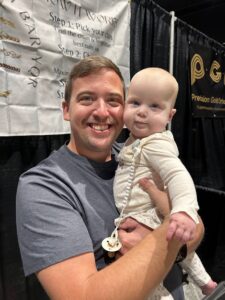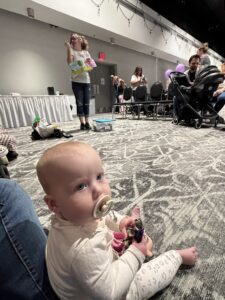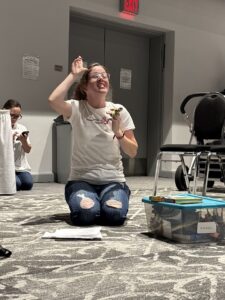Signing, Singing, and Growing: My Ongoing ASL Learning Journey
A Weekend of “Sing & Sign” Fun


Over the last couple of weeks, my major learning project has continued to grow in the best way possible. I was fortunate enough to attend another Sing & Sign session led by Jess, the owner of Stay ‘n’ Play Parenting. This one took place at the Bump, Babe, and Beyond Expo at the Conexus Arts Centre here in Regina where my wife was working at one of the booths! It worked out perfectly as I was able to join in the class with our daughter, Blakely. The theme that day was animals, and it was such a fun, hands-on learning experience. We sang, signed, and played together while learning new ASL signs such as dog, cat, bird, cow, horse, sheep and elephant. I was amazed at how naturally Jess ties signs into music and movement; it made learning feel effortless and memorable. It was also just so special to share that experience as a family.
Interview with Jess (Stay ‘n’ Play Parenting Owner)

This past week I also had the privilege of interviewing Jess about her background, experiences, and passion for bringing baby sign language to families in Regina. Her story is incredibly inspiring (especially her journey from being a preschool teacher to becoming a Deaf ally and advocate after learning ASL to communicate with her own daughter).
1. What inspired you to start the Stay ‘n’ Play Parenting Network?
I used to be a preschool teacher 2014-2018 and saw that my kids were really enjoying learning signs throughout our routines. Resources for families in Regina before preschool age was really limited at the time, so I made the switch from preschool to postpartum/toddlerhood to support families during a difficult time of the parenting journey.
2. How did you first get into sign language?
I started using ASL in 2014, when my now 12.5 yr old was 16 months. It was around this time we found out she had a severe-profound bilateral hearing loss. We had never met a Deaf person in our life, and knew no sign language at the time. We went looking for funding to help cover her first pair of hearing aids, and reached out to Saskatchewan Deaf and Hard of Hearing services. They provided us with something even better than financial support; they gave us a language to communicate with her as she was significantly speech delayed for quite a long time. I have taken several classes through them (some even twice just to refresh), and am an active member in the Regina Deaf community, as well as a Deaf Ally and Advocate. Although now she prefers to be more oral, there are times she still requires ASL; such as on her tech-free days to be included in conversations, if the listening environment is too loud for clarification, as well as in the classroom for understanding of teacher instructions.
3. What online resources or apps do you highly recommend to someone who is wanting to learn ASL or baby sign language?
–Saskatchewan Deaf and Hard of Hearing Services: Online and in person ASL classes for adults taught by Deaf individuals. Also provide interpreting services and other supports for DHH individuals and their families.
-My Signing Time App: Kid friendly subscription app that has all of Two Little Hands Productions content on it for viewing. Created by a mom with a DHH child to help other families have a resource to learn ASL.
-ASL Nook: Deaf created, kid-friendly YouTube channel.
-Bill Vicars/Lifeprint: Deaf created website that has videos of basic ASL, as well as practice lessons
–BabySignlanguage.com : Online resource with basic ASL to use with communication. I’m not sure of their backstory, but I found them helpful when we were first learning.
4. From your experience, what are the biggest benefits of baby sign language for children and families?
We signed with all four of our kids, and it made a world of difference being able to communicate with them a little bit earlier. Our eldest boy had a bit of a speech delay, as we were mostly signing in the house at the time, so having ASL helped him still be able to communicate with us. Our hearing kids were less frustrated as toddlers because they could tell us what they wanted before they could talk.
5. Do you find certain signs are especially helpful for babies to learn first?
Eat, more, please, all done, milk are usually the first signs babies learn first. They are the most developmentally friendly with their simplicity, and they are power words to get what they need. Not all signs are made correctly when babies start expressing themselves through sign, a lot of time it’s an approximation, but they still count as communication.
6. Are there any common misconceptions parents have about baby sign language?
Yes! It is believed that if they use sign language they won’t learn to talk. This is especially real for DHH children, with many being denied access to their right to language because of this audist view. Many DHH children and their families (ours included) have been denied services because of our decision to use a bi-lingual, bi-cultural approach.
7. What does a typical Sign & Sign class look like?
We usually start with our opening exercises, then an overview of the signs we’ll explore, followed by activities, then closing exercises with a review of signs from the day. Families are emailed a short video recap for reference, as well as lyrics to songs to use at home.
8. How do you see baby sign language connecting families to the larger Deaf/Hard of Hearing community, if at all?
All signs in our Sing and Sign class use real ASL, we are just highlighting key words rather than creating complete ASL sentences (the grammar and syntax are completely different from English, and should be taught by a Deaf adult). So if someone from Sing and Sign met a DHH person, they could use content from class and the DHH should understand their point. It also helps spread awareness for the DHH community and that diversity is beautiful.
9. Can you share a success story or memorable moment from a family in your program that really showed the impact of baby sign language?
Oooo so many… Not a specific moment, but I love to see when a child makes an impromptu sign during class. We often work on more with an intention to repeat an activity so many times. Sometimes babes will enjoy the activity so much that they’ll sign for more unprompted, so we do it one more time to solidify the understanding of more.
10. Where do you see baby sign language education heading in the next 5–10 years? Do you think it will become more mainstream for families and early learning programs?
Yes! I think DHH awareness is really spreading and more families are becoming interested in using ASL to communicate with their littles. It is definitely becoming more mainstream even within the last 5 years, which is great for everyone!
I loved Jess’s emphasis on connection and inclusion. Her passion for ASL not only supports communication for little ones but also helps bridge hearing and Deaf communities through awareness and understanding.
Learning Through Apps and Daily Practice

Outside of these in-person experiences, I have continued with my daily ASL Pocket Sign app lessons. Although I tend to lose my streak here and there when I seem to get caught up in the business of things, I am proud to say that I am now on level 26! Each session adds to my vocabulary and helps reinforce what I’ve learned through real-life interactions such as the Sing & Sign classes.
Recently, I’ve also started planning my final project baby sign language video for Blakely that I’ll create using Canva. It’ll feature the everyday signs we use at home, like more, please, eat, all done, and milk, along with some new ones I’ve picked up along the way. I want it to feel like a fun “Ms. Rachel style” family video that she can watch (and sign along with!) while I’m away at work.
Reflections & Takeaways
This week really reminded me how powerful and important language can be in connecting people, especially when it’s a visual and expressive one such as ASL. I have learned that ASL is about so much more than just learning hand signs. ASL is also about building connections, finding new ways to communicate, and appreciating all the different ways people can share meaning and communicate with each other.
I’m extremely grateful for people like Jess who make learning accessible, joyful, and meaningful for families like mine. I can already see how baby sign language is helping us connect with Blakely in small but powerful ways. (Huge shoutout to Jess for taking her time out of her busy schedule to do this interview with me!!)
Next week, I plan to continue exploring additional and other online ASL content, such as the ones mentioned by Jess and keep building my Canva project slides for my final project. I’m excited to bring all of these pieces together into a final product that reflects what I have learned, while also supporting my family!
Until next time,
Jordan Schutz
5 thoughts on “Signing, Singing, and Growing: My Ongoing ASL Learning Journey”
Hi Jordan!
What an amazing opportunity you had by interviewing with a local expert! My pre-existing knowledge of ASL is limited, but I learned a lot from reading the interview. I like that you focused a lot of your questions on misconceptions and how to find and use the resources out there. Have you been doing much ASL at home with your daughter since going to these classes? Have you noticed her signing much at home?
Hello Daegan,
Thank you for the reply! I am glad to hear that you were able to take something away from my blog post and interview with Jess! My wife and I quite regularly do the basic signs at home in front of our daughter (such as milk, more, please, eat, happy, play, mom, dad, etc.). She is only 8 -months old and is not really using the signs yet, but she seems to be starting to use the sign for “more”. We are hoping if we continue using the signs that I am learning, she will begin to sign more in the coming months!!
Jordan,
I found your blog very insightful this week. You not only included an excellent interview with a local expert, which made the post feel much more personal, but I also liked how you provided resources such as the apps for daily practice. This gives others the opportunity to explore ALS independently. Finally, my favourite part was your reflection, it highlighted that ALS is more than just communication; it’s a way to build connection, relationships, and understanding between people, and most importantly, with your daughter.
Hi Amber,
Thank you for the reply! I am glad to hear that you found my blog post to be insightful! I was thrilled Jess was able to do this interview with me as it for sure added a personal and meaningful touch to my major learning project on ASL.
Hey Jordan
This was such a heartwarming post to read! I really liked how you shared your experiences from the Sing & Sign class; it sounded like such a fun and meaningful way to learn ASL while bonding with your family. The animal theme made it even more engaging, and it’s wonderful that you could share that special time with your daughter. The interview with Jess was also so inspiring! Her journey from being a preschool teacher to becoming an advocate for the Deaf community really shows how powerful language and communication can be.
I also think it’s great that you’re using both in-person learning and the Pocket Sign app to keep practicing. Reaching level 26 is an awesome achievement! The idea of creating a baby sign language video for Blakely is so creative and thoughtful; it’ll be such a special keepsake for your family. Your reflections really highlighted the beauty of ASL as more than just a language; it’s a bridge that connects people in new and meaningful ways.